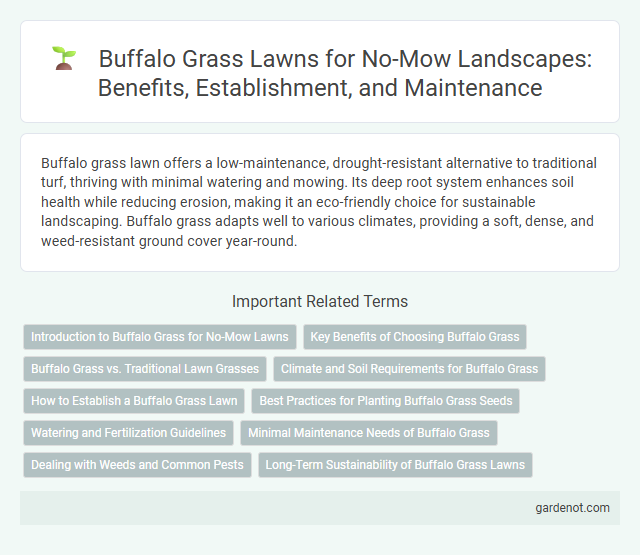Buffalo grass lawn offers a low-maintenance, drought-resistant alternative to traditional turf, thriving with minimal watering and mowing. Its deep root system enhances soil health while reducing erosion, making it an eco-friendly choice for sustainable landscaping. Buffalo grass adapts well to various climates, providing a soft, dense, and weed-resistant ground cover year-round.
Introduction to Buffalo Grass for No-Mow Lawns
Buffalo grass, a native North American prairie grass, is ideal for no-mow lawns due to its low growth habit and drought tolerance. Its fine texture and soft green color provide an attractive, natural turf that requires minimal maintenance and infrequent watering. This grass species thrives in full sun and adapts well to various soil types, reducing the need for chemical fertilizers and frequent mowing.
Key Benefits of Choosing Buffalo Grass
Buffalo grass offers exceptional drought tolerance, reducing water consumption by up to 50% compared to traditional lawn grasses, making it an eco-friendly choice for sustainable landscaping. Its low growth habit significantly minimizes mowing frequency, saving time and maintenance costs while maintaining a neat and lush appearance. Additionally, Buffalo grass is highly resilient against pests and diseases, enhancing lawn durability and long-term aesthetic appeal in various soil types.
Buffalo Grass vs. Traditional Lawn Grasses
Buffalo grass offers a low-maintenance, drought-tolerant alternative to traditional lawn grasses such as Kentucky bluegrass and Bermuda grass, requiring significantly less water and fertilizer. Its deep root system enhances soil health and reduces erosion while maintaining a soft, dense turf ideal for no-mow lawns. Buffalo grass's slow growth rate minimizes mowing frequency, making it an eco-friendly choice for sustainable landscaping.
Climate and Soil Requirements for Buffalo Grass
Buffalo grass thrives in warm, semi-arid climates, tolerating temperatures ranging from 70degF to 95degF and withstanding occasional drought conditions. It prefers well-drained, sandy to loamy soils with a pH level between 6.0 and 7.5, making it ideal for regions with low to moderate rainfall. This resilient grass type adapts well to poor soil fertility, reducing the need for frequent fertilization and maintenance.
How to Establish a Buffalo Grass Lawn
Establishing a buffalograss lawn involves selecting high-quality buffalograss seed or sod suited for warm-season climates, ideally planted in late spring to early summer when soil temperatures reach at least 65degF. Prepare the site by removing existing vegetation, loosening the soil, and ensuring proper drainage, then evenly distribute the seed or lay sod with firm soil contact to promote root growth. Maintain consistent moisture through light, frequent watering until the grass establishes, reducing frequency as it matures to encourage deep rooting and drought resistance.
Best Practices for Planting Buffalo Grass Seeds
Buffalo grass thrives in well-drained soils with full sun exposure, making soil preparation essential for successful planting. Plant seeds in late spring or early summer when soil temperatures consistently reach 65degF to 75degF, ensuring optimal germination. Maintain consistent moisture without overwatering during the establishment phase to promote deep root growth and drought tolerance.
Watering and Fertilization Guidelines
Buffalo grass lawns require infrequent watering, typically needing about 1 inch of water per week during dry periods to maintain healthy growth while conserving water. Fertilization should be minimal, with a light application of a balanced, slow-release fertilizer in early spring and again in late summer to promote deep root development and drought resistance. Overwatering and excessive fertilization can lead to shallow roots and increased susceptibility to pests and diseases.
Minimal Maintenance Needs of Buffalo Grass
Buffalo grass requires minimal maintenance, thriving with infrequent mowing typically every 3 to 4 weeks due to its slow growth rate. This drought-tolerant turf adapts well to various soil types, reducing the need for frequent watering and fertilization. Its natural resistance to pests and diseases further minimizes upkeep, making it an ideal choice for low-maintenance lawns.
Dealing with Weeds and Common Pests
Buffalo grass lawns naturally resist many common weeds due to their dense growth habit, reducing the need for chemical weed control. Managing pests like grubs and armyworms involves maintaining healthy turf through proper watering and mowing practices, as stressed grass is more susceptible to infestations. Organic treatments and beneficial nematodes can effectively address pest issues while preserving the lawn's low-maintenance, no-mow benefits.
Long-Term Sustainability of Buffalo Grass Lawns
Buffalo grass lawns demonstrate exceptional long-term sustainability due to their deep root systems, which enhance drought resistance and soil health. This native grass requires minimal water, reduces lawn maintenance, and supports biodiversity by providing habitat for various insects and small wildlife. Over years of low input care, buffalo grass maintains dense coverage, effectively preventing erosion and reducing the need for chemical fertilizers or pesticides.
Buffalo grass lawn Infographic

 gardenot.com
gardenot.com